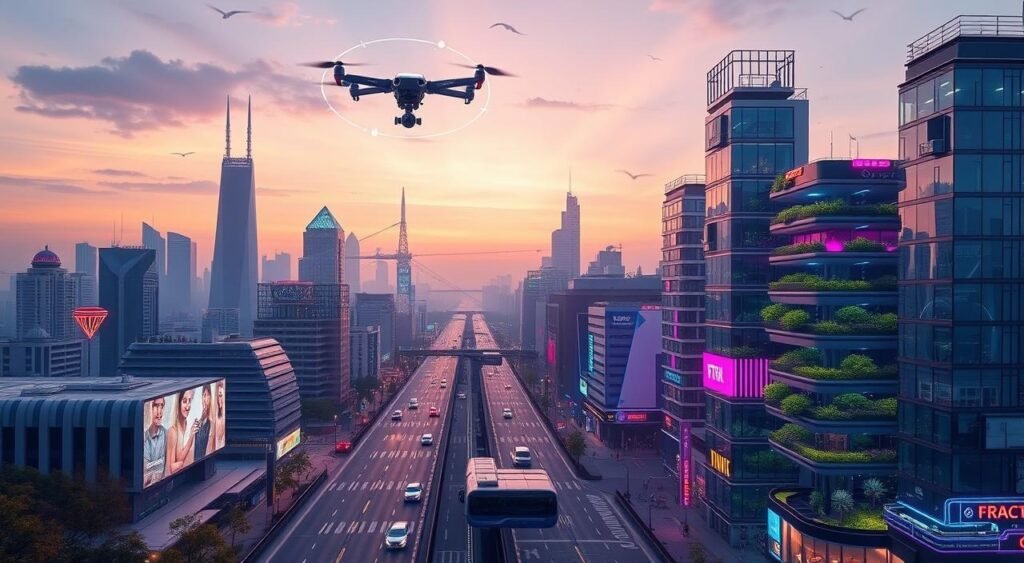
In today’s fast-changing business world, knowing how to use new technologies is key. Busbis 1660 is a top guide for businesses. It explores the world of new innovations, showing the trends, strategies, and examples that are changing industries worldwide.
Disruptive technologies are big improvements that change how things work. They offer better solutions than what we have now. Clayton Christensen, a famous Harvard Business School professor, first talked about disruptive innovation in the 1990s. He helped us understand how markets change with new technologies1.
These new technologies start small but soon become big, replacing old ways of doing things. Knowing about these technologies early can help businesses stay ahead. It helps them find new ways to grow and change2.
Key Takeaways
- Disruptive technologies are innovations that significantly transform industries and disrupt established business models.
- The concept of disruptive innovation was introduced by Harvard Business School professor Clayton Christensen in the 1990s.
- Recognizing and embracing disruptive technologies can provide organizations with a competitive edge and opportunities for growth.
- Busbis 1660 is a comprehensive guide that explores the latest trends, strategies, and case studies in the world of disruptive technologies.
- The guide covers a wide range of emerging technologies, including artificial intelligence, machine learning, and blockchain, among others.
Understanding the Impact of Disruptive Technologies on Modern Business
The business world is changing fast, thanks to new technologies. These changes force companies to rethink their plans and accept big changes. It’s key to know what makes these technologies special to keep up with the digital world.
Defining Radical Innovation and Transformation
Disruptive technologies are not just small updates. They bring new ways to solve problems that old solutions can’t handle. They’re also cheaper and easier to get, helping more people or special groups.
Key Characteristics of Disruptive Technologies
Disruptive technologies can grow fast and change whole industries. Scalability lets them quickly affect big players, creating new chances. As they get better, they beat older tech in cost and quality. Knowing this helps companies adapt and benefit from these changes.
The Role of Scalability and Performance
As these technologies grow, they often do better than old ways. This lets businesses reach new customers. By using these new ideas, companies can change and stay ahead in their fields.
| Characteristic | Description |
|---|---|
| Radical Innovation | Disruptive technologies introduce entirely new methods of solving problems, challenging existing solutions. |
| Accessibility | These technologies are often more affordable and accessible, reducing costs and making solutions available to larger populations. |
| Scalability | Disruptive technologies can quickly scale and transform entire industries, opening new business opportunities. |
| Performance Improvement | Over time, disruptive technologies improve in cost-effectiveness and performance, becoming increasingly competitive. |
Knowing how new technologies affect business helps companies stay ahead. They can use these changes to keep winning in the digital world.
“Embracing disruptive technologies is not an option, but a necessity for businesses seeking to thrive in the digital age.”
Essential Components of busbis 1660 disruptive technologies

Technological advancements have changed many industries3. busbis 1660 disruptive technologies include innovations like AI, blockchain, and 5G. They change how businesses work and interact with customers. Electric vehicles and quantum computing are also part of this change.
AI and ML make machines smarter, learn from data, and make decisions3. Blockchain is a secure way to record transactions, changing finance and supply chains.
5G networks bring fast, reliable internet, supporting many devices and the IoT. Electric vehicles are making cars greener, changing the auto industry.
Quantum computing is a big leap in computing, solving complex problems fast3. Gene-editing, like CRISPR-Cas9, is changing medicine and biotech, leading to new treatments and research.
These technologies are changing industries, driving new ideas, and opening up business opportunities3. By using these technologies, companies can stay competitive and grow in the digital world.
| Disruptive Technology | Key Characteristics | Impact on Industries |
|---|---|---|
| Artificial Intelligence and Machine Learning | Mimics human intelligence, learns from data, optimizes processes, and predicts outcomes | Transforming decision-making, automating tasks, and improving efficiency across various sectors |
| Blockchain Technology | Provides a secure, decentralized, and immutable digital ledger for transactions | Revolutionizing finance, supply chain management, and various other industries |
| 5G Networks | Offers faster, more reliable connectivity, supporting a massive number of connected devices | Enabling the growth of the Internet of Things (IoT) and driving innovation in various industries |
| Electric Vehicles | Leading the charge towards sustainable mobility, disrupting the traditional automotive industry | Promoting eco-friendly transportation and transforming the mobility landscape |
| Quantum Computing | Represents a breakthrough in computing power, offering exponentially faster processing speeds | Solving complex problems and driving advancements in various fields, including cryptography and materials science |
| Gene-editing Technologies (CRISPR-Cas9) | Revolutionizing the fields of medicine and biotechnology, enabling personalized treatments and genetic research | Transforming healthcare and paving the way for groundbreaking advancements in genetic engineering |
These essential components of busbis 1660 disruptive technologies are reshaping industries, driving innovations, and creating new opportunities for businesses to thrive in the ever-evolving digital landscape3. By understanding and leveraging the potential of these transformative technologies, organizations can stay ahead of the curve and maintain a competitive edge in the face of rapid technological advancement.
“Disruptive technologies are not just about changing the way we do things; they’re about changing the fundamental assumptions underlying the way we do things.” – Clayton Christensen, Harvard Business School Professor
Artificial Intelligence and Machine Learning: Transforming Industries
Artificial intelligence (AI) and machine learning (ML) are changing many industries fast. They bring new solutions and change how businesses work. These technologies are making healthcare, finance, and retail better by making things more efficient, personal, and predictive4.
Healthcare Applications and Innovations
In healthcare, AI is changing how we diagnose and treat diseases. It uses data to find patterns early, helping doctors give better care. AI also helps find new medicines and makes clinical trials faster, improving health care for everyone4.
Financial Sector Transformation
The finance world is using AI and ML to fight fraud and make trading smarter. AI helps find hidden trends in big data, helping banks make better choices. It also makes customer service better with chatbots and automated advisors5.
Retail Industry Evolution
Retail has changed a lot with AI and ML. Stores use these tools to manage stock better, make shopping personal, and guess what customers want. AI helps pick the right products for each customer, and automation makes supply chains smoother4.
As AI and ML get better, they will change industries even more. Businesses that use these technologies will do well in the digital world45.
Emerging Technologies Shaping the Future of Business

The business world is changing fast, thanks to new technologies. Blockchain, 5G networks, electric vehicles, and quantum computing are leading the way. These innovations will change how we work and make decisions.
Blockchain technology is changing finance by making transactions faster and safer. It’s also improving supply chains by making data more transparent and traceable.
The introduction of 5G networks will impact telecom, transport, and healthcare. It will make communication almost instant, helping develop self-driving cars and remote healthcare.
The shift to electric vehicles is growing, driven by green goals and less pollution. Better batteries and charging systems will make electric cars the standard, changing the car industry and transport.
Quantum computing will change many fields, like cryptography and drug discovery. It can solve complex problems that regular computers can’t, giving businesses a big advantage.
As these technologies grow, businesses need to keep up and use them wisely. This will help them stay ahead and shape their industries’ futures.
Strategic Implementation of Disruptive Technologies
Businesses need to think ahead and be quick to adapt in today’s fast-changing world. Investing in research and development (R&D) is key to staying ahead. It helps create a culture of innovation3. By exploring new tech, companies can find new ways to change their industries.
Also, building collaborative partnerships with startups and tech firms is important. These strategic partnerships help businesses get new ideas and work together. This teamwork keeps them ahead of the game.
Investment in Research and Development
Putting money into R&D is a smart move. It lets businesses lead in innovation and keep up with new tech. By looking into new tech, they can find big changes for their industries3.
Building Collaborative Partnerships
Working with startups and tech firms speeds up the use of new tech6. These partnerships let businesses share ideas and work on new solutions. This teamwork makes them more agile and ready for change.
Risk Management and Adaptation Strategies
With new tech, there’s always uncertainty. Businesses need to plan for different scenarios and manage risks. By getting ready for changes, they can adapt fast and stay strong. This way, they’re ready to grab new chances.
“The key to success in the age of disruption is to embrace change, foster a culture of innovation, and be agile in responding to evolving market demands.”
Conclusion
Disruptive technologies are changing industries and opening new doors for businesses7. Technologies like artificial intelligence and blockchain are making big waves7. Companies that get on board with these changes will do well in our digital world7.
To succeed, businesses need to be innovative, form strong partnerships, and stay quick on their feet7. Those that focus on adapting to new tech will have a big edge7. As innovation speeds up, companies must be ready to change and use new tech to grow7.
By embracing new tech, companies can lead their fields and find new ways to succeed7. The future is for those who are brave, keep learning, and use new tech to stay ahead7.
FAQ
What are disruptive technologies?
Disruptive technologies are new innovations that change how we do things. They offer better ways to solve problems than what we have now. This makes current ways of doing things less relevant.
How do disruptive technologies differ from incremental improvements?
Disruptive technologies bring new ways to solve problems that old solutions can’t handle. They are often cheaper and more accessible. This makes solutions that were once expensive now available to more people.
What are some examples of busbis 1660 disruptive technologies?
Examples include Artificial Intelligence (AI) and Machine Learning (ML), Blockchain, 5G networks, Electric Vehicles, Quantum Computing, and Gene-Editing like CRISPR-Cas9.
How are AI and ML transforming various industries?
AI and ML are changing many industries. In healthcare, they help with diagnosing and treating patients. In finance, they help with fraud detection and customer service. In retail, they improve inventory management and shopping experiences.
What are the key strategies for navigating disruptive technologies effectively?
Key strategies include investing in R&D and using agile methods. Forming partnerships with startups and tech companies is also important. Scenario planning helps in managing risks.
Source Links
- EASY BRIC – https://www.caen.it/products/easy-bric/
- Course Information – University of Pittsburgh – https://catalog.upp.pitt.edu/content.php?catoid=223&navoid=22725&filter[32]=1&filter[exact_match]=&filter[keyword]=&filter[course_type]=&filter[27]=&filter[29]=&filter[item_type]=3&filter[only_active]=1&filter[3]=1&filter[cpage]=35&expand=1&print
- Program: Business Information Systems, BSBA – University of Pittsburgh – https://catalog.upp.pitt.edu/preview_program.php?catoid=225&poid=70790&returnto=23322
- Designing Deep Learning Hardware Accelerator and Efficiency Evaluation – https://pmc.ncbi.nlm.nih.gov/articles/PMC9300348/
- The Best GPUs for Deep Learning in 2023 — An In-depth Analysis – https://timdettmers.com/2023/01/30/which-gpu-for-deep-learning/comment-page-1/
- Novl Tech: Transforming Project Management for Architects and Engineers with AI-Powered Solutions – Tech Trend Chronicles – https://techtrendchronicles.com/novl-tech/
- Intellectual Property and the Incenvtive Fallacy – https://law.depaul.edu/academics/centers-institutes-initiatives/center-for-intellectual-property-law-and-information-technology/programs/Documents/ipsc_2011/papers/JohnsonE_Paper.pdf
